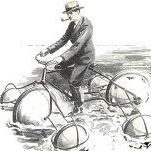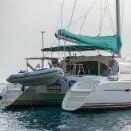Leaderboard
Popular Content
Showing content with the highest reputation on 06/02/18 in all areas
-
This post cannot be displayed because it is in a forum which requires at least 10 posts to view.
-
We had a professional (very nice chap with an impressive beard) in 2016 and a volunteer in 2017, so you may well be right. As far as the "and it shows" bit is concerned, yes it does, but the volockies at Watford do a pretty thankless job balancing queues top and bottom of the locks and trying to keep everyone sweet, so perhaps we should cut them some slack.3 points
-
This post cannot be displayed because it is in a forum which requires at least 10 posts to view.
-
I wrote this elsewhere but as the same questions pop up regularly I thought it might be an idea to post it here. I don’t intend this to be an exhaustive in-depth ‘instruction manual’ which covers all aspects of marine battery charging, there are already many web sites and books which attempt to do that. Rather, this describes, in pretty broad brush strokes, my opinion of how to approach the matter while taking into account your boating style. It’s also not written with substitute examples (like buckets for batteries) but with real products that you may have on your boat.While I’ve tried to avoid being overly technical whilst describing what is a highly technical subject, there are nevertheless mentions of volts and AmpHours here. Despite that, I’ve intended it to be reasonably light reading for those with a little knowledge of the subject yet possibly containing some nuggets of useful information for those who know the subject quite well. It's also worth pointing out that there is no such thing as 100% charged; by the very nature of its chemistry a battery can never get there. You can always squeeze just a tiny bit more in. However I will refer to 'fully charged' as meaning "as charged as practical" !Please read the couple of safety points at the end of this post. It’s more than possible that I’ve overlooked something or made errors in which case I’m sure you’ll let me know . So, here we go.Battery charging is a topic that generates almost more discussion on any boating forum than anything else. This article tries to set out the basics for keeping your batteries healthy and happy, but can only be an introduction to such a complex business. Let us first understand the problem. When sitting in the cabin with no engine or generator running, you are consuming power from your batteries. TV, radio, lighting, pumps, phone chargers etc. all use power. Now, if you cruise for a number of hours the following day then it is possible, depending on how many hours that your engine is running, that your alternator will have replenished the lost charge by the time you moor up for the evening. Then you start the cycle again.In the summer a good solar installation can take care of some or even all of your charging needs (depending on the sunshine and the size of the solar panels). In the winter solar will not achieve this. In fact you will experience days or even weeks where the solar contributes virtually nothing at all. Wind generation is of even less value.If you require extra battery charging then the solution is therefore a mains battery charger. What type, how it is used, and how it should be configured is covered in the following sections.Before we get to that, let us first understand what a modern, microprocessor controlled battery charger does. All modern battery chargers have three basic stages. Marketing departments will sometimes advertise 4, 5, or even 6 stages of charging but that is purely so they can make their charger appear superior to the competition. For a straightforward recharge of discharged batteries there are only three stages. (Equalisation or Desulphation are not a charge stage, they are a maintenance stage). So, what are these three stages?1. Bulk Stage. This is when the batteries are at their lowest SoC (State of Charge) and will 'demand' the maximum output from the charger. All chargers are categorised by their maximum current rating (20A, 40A etc) and during the Bulk Stage the current will be at this maximum while the voltage slowly rises up to the preset maximum (typically 14.4 to 14.7V, depending on battery type and internal chemistry). This stage is sometimes called "Constant Current". Note that the size of the charger (its maximum current) should be chosen to suit your usage, the size of the battery bank and the battery type. How this is arrived at is outside the scope of this post.2. Absorption Stage. The batteries have now reached a higher SoC (typically around 80-85%) and are gradually demanding less and less from the charger. The voltage remains at the preset level (typically somewhere between 14.4v to 14.8V) whilst the current slowly reduces. This stage is sometimes called "Constant Voltage". This stage should continue until the batteries are very close to 100% charged.3. Float Stage. Depending on your charger's float voltage this can be considered to be similar to the Absorption Stage inasmuch as the voltage is constant, but the voltage is now reduced to around 13.6V (again, preset according to battery type and internal chemistry) in order to treat the battery gently and to slowly bring it to a fully charged state whilst simultaneously countering self-discharge. Some chargers, however, have a much lower float voltage of only around 13.25V. If yours is one of these then float should be considered as a maintenance stage because it will not charge the battery, only keep it at its current state of charge.Self-discharge is where a charged battery will slowly lose its charge if left unattended.How a battery charger should be used and configured depends largely upon your boating style, which is discussed below.There are three main scenarios for using the batteries which will be taken in turn.If you are off-grid with no access to shoreline If you never have an opportunity to plug your boat into a shoreline and solar/wind is insufficient then you are reliant on either the engine alternator or a TravelPower or separate generator to feed an on-board charger. Whichever of these two methods you use (engine or generator), you will be limited in how long you can run it. CRT licence conditions do not permit the running of engines or generators for charging purposes outside the hours of 8 am to 8 pm and in any event, it is highly inconsiderate to spoil the peace of an evening on the cut with engine noise. Besides, why add wear to the engine and use fuel any more than is essential?Note that thanks to something called Charge Efficiency (don't worry about it, just accept this), more energy needs to be replaced when charging than you took out when discharging (by a factor of around 10-20%). It is impossible to tell from a simple volt meter when the bank is fully charged. In brief, you will need to monitor either the specific gravity (relative density) or an ammeter to know when it is safe to stop charging. This is particularly pertinent to off-grid boaters who for reasons of noise and expense of fuel do not wish to charge for hours on end when unnecessary.If using the SmartGauge to monitor your batteries, be aware that it is not as accurate when charging as discharging and therefore continuing charging for some time after it shows 100% may be advisable. If using a monitor that contains an ammeter, you need to watch the current flow into the battery bank. It will start very high during the bulk phase, then tail off during absorption. When it has either stopped reducing over a period of an hour or reached 1 - 2% of the bank's capacity, then little will be achieved by continuing charging. So for a 400 Ah bank, for example, you should aim for a "tail current" of 4 - 8 amps if it is achievable.There is however a problem with most (if not all) battery chargers. When charging with a generator and 'mains' battery charger it is very important to note that many chargers switch to float voltage much too soon. This is because the designer was imagining them being used on a never-ending household mains supply, and switching to float early treats the batteries gently at the expense of charging time. An off-grid boater needs the opposite; he needs the batteries to charge as fast as possible so that he can switch off his generator as early as possible. Ideally, an off-grid boater doesn't want the charger to ever switch to float; simply continue at absorption voltage until the tail current indicates that the bank is fully charged. Note however that this requires the boater to be vigilant. Continuous charging at the Absorption voltage once the batteries are charged will irreparably damage your batteries.Some chargers permit the user to configure the settings to a large degree, and I would advocate, where possible, that an off-grid boater should set the float voltage to be the same as the absorption voltage - somewhere in the order of 14.4V depending on the make of battery. It is important to repeat the advice that if you do this you must be vigilant and stop charging once the batteries are close to 100% SoC.Although somewhat inconvenient and requiring experience, it is possible, once charging has finished, to use an accurate voltmeter to estimate the state of charge, but only once the surface charge has been eliminated. One way of doing this would be to turn the tunnel light on for around 10 minutes. This table shows the relationship between resting voltage and charge state of a typical 12V bank:12.65V - 100%12.45V - 75%12.24V - 50%12.06V - 25%11.89V - 0%The highly accurate way to check the state of charge of individual cells is to use a hydrometer or refractometer to measure the relative density of the electrolyte but many boaters will not wish to go to those lengths and those with sealed, AGM or gell batteries will not be able to do so anyway.You should aim to fully charge the batteries daily for maximum life. If that is impossible, then every few days, certainly every week, to avoid sulphation permanently reducing the bank's capacity.If you are off-grid with occasional access to shoreline If you are able to get into a marina occasionally and plug into a shoreline, then you can give the batteries a much more thorough charging. Leaving the charger on until it goes into float mode, turning it off for a while then back on, will result in the batteries being brought to a much better state. Ideally, leave the charger on overnight.If you have configured the Float Voltage to be high as described above for off-grid boaters then it is essential that you change it back to a suitable float voltage for your batteries when connected to shore power.If you have regular access to shoreline If you regularly moor in a marina or somewhere else where you can use a shoreline, then in addition to all of the foregoing you can routinely leave the bank on float charge. Most modern chargers will go back into absorption mode from time to time to ensure that the batteries are kept in good condition.During the summer, a decent solar panel array will achieve the same effect, keeping a float level of charge across the bank, as long as your power usage is less than that which the bank is producing, but the weak UK winter sun will not be adequate for this purpose.EqualisationYes, I know it's not a 'charge mode' but I thought I'd add a little about it here anyway. Some chargers will enable you to give an equalisation charge at a much higher voltage than usual, probably above 15V for a 12 volt system. This has the effect of ensuring that all the cells in the bank have been fully charged and that as much sulphation as possible has been removed from the plates. Some warnings about equalisation: 1. Sealed, AGM and gel batteries should not normally be subject to equalisation. If you are considering doing so, take expert advice first.2. Some items of equipment in the boat may not be able to handle the high voltage and should be disconnected. The safest way is to isolate the bank before proceeding.3. Hydrogen gas will be given off during the process. The bank should be well ventilated and must never be left unattended. During equalisation, check the temperature of the batteries from time to time, say every 15 minutes. They may well become warm to the touch but serious heating is a bad sign and the process should be stopped at once. It is not unknown for batteries to boil or even explode if a cell has failed.4. The cells will need topping up with distilled water after being equalised.A couple of general bits of safety advice should be added here:1) A permanently installed charger must never use crocodile clips to connect to the battery. 2) Temporary chargers should only be connected with the input (230V mains) power turned off, and only disconnected 3 minutes after turning off the charger input power to minimise the risk of explosion from hydrogen gas generated during charging.2 points
-
This post cannot be displayed because it is in a forum which requires at least 10 posts to view.
-
This post cannot be displayed because it is in a forum which requires at least 10 posts to view.
-
I agree. We just have to make a choice. I really knew nothing about narrowboats when i made my decision to sell up in 2013. I just looked at alternative options. I,m early retired, no kids, and a foreign partner who is small and adaptable. So i jumped for the canal boat. I,d sailed boats and im an engineer so it didnt daunt me. Once i,d dumped the flat and began my new adventure, life just got better everyday i cruised, and met nice kindred folk, helpful, friendly and respectful of each other and the environment. The thought of sitting lonely in a flat just isnt in my mind anymore. Maybe with old age infirmity i,ll have to deal with that but at today,s fit n fairly healthy 64 years, i,ve still got 10 or more years to enjoy outdoors with nice folks. I know nice old Baz aboard Country Dreaming still cruising around Braunston area at 80 years young, fit n full of fun. Thats my target too. " better remorse, than regret " ( better to be sorry you did something, than to be sorry later for not doing it). Tempus Fugit.2 points
-
This post cannot be displayed because it is in a forum which requires at least 10 posts to view.
-
I have scanned the various replies and am not sure I agree with some of them.. 22 years ago , following the death of my wife, I looked around for an interest in life. A long term coastal sailer I had never set foot on a a narrowboat. I was a lifelong 'pen pusher' with no technical qualifications beyond an 'O' level in woodwork. I was practical and was able to read. I was also able to afford to make mistakes (pride requires me to say I didn't make many). I also had no deadline or time constraint. Indeed the longer it took the better from my point of view. I bought a 55' bare shell in primer and turned it into an excellent (though now dated) boat. Throughout, the very best of materials were used. Oak ply, no MDF whatsoever, African then Brazilian and English oak hardwoods. Overspeced wiring, plumbing, fittings etc. That's not to say I threw money at it. The engine (a BMC 1800) was a £100 scrapyard purchase that I stripped to the last nut and bolt and re-built. At no time in the boats life has anything broken or fallen apart (apart from normal wear and tear). I doubt if the same could be said of many production boats of it's age. Somewhere I'm sure I've got one or two photos of various stages of build but not a chronicled record. I did it as a labour of love not a record to prove what I had done. I may have lost track of the OPs point (it was a good bottle of wine) but my advice would be to look in depth and objectively at any boat. Paper and photos don't float. Frank (hic) Ref the statement " nothing has broken" etc. I forgot about the gearbox separating inexplicitly from the engine a couple of years ago2 points
-
Before speculation goes any further and gets me into trouble I thought it time to make an announcement: On 07 October 2017 I entered an agreement with the owners of OTLEY, and all being well we are planning the handover of ownership to take place on 07 April 2018. My plan is to then bring OTLEY to the midlands for refurbishment work1 point
-
This post cannot be displayed because it is in a forum which requires at least 10 posts to view.
-
This post cannot be displayed because it is in a forum which requires at least 10 posts to view.
-
Thanks a lot for the input everyone. It just doesn't pay to do it, either financially or as far as sense and risk goes. So I'll be sticking with it. Instead I've explored a happy medium - releasing/borrowing against some of the equity in my home with my current lender. I've found some lovely boats for around the £20K mark and it'll still leave me with a decent amount of equity in my home and I'll still keep a foot on the ladder.1 point
-
1 point
-
A very significant point and one not realised by many people. Just fitting a bigger alternator will not significantly decrease your charging time. This is because the charge current is controlled by the battery not the alternator. The only way to increase the charging current is to increase the charging voltage. You can have a 100A alternator, but I bet, with 50% discharged batteries of 440Ahr capacity, the charge current will have dropped to 30-40A within half an hour. However as Eeyore points out, you will gain if using the inverter to draw a high current, but only when the inverter is supplying that high current.1 point
-
The only one that Google seems to know about was in the USA in 2015 and was on a 'Petrol' engine boat. Joseph Sheehan, 46, remained in critical condition Tuesday morning at Westchester Medical Center in the aftermath of the explosion just before 7 p.m. on Tuesday, Sept. 1, that destroyed a 28-foot Chaparral boat at the dock at Fischer’s Marina on the east shore of Lake George. Mr. Sheehan, 46, of Manhattan was severely burned in the accident. He had brought the boat in for gas. “It appears as though the dock attendant may have been directed to put the gas into the wrong cavity of the boat.” And we know that because he pumped 15 gallons, and there wasn’t 15 gallons of fuel in the gas tank, which was not breached as a result of the explosion,” Warren County Sheriff Lieutenant Steve Stockdale told The Chronicle Tuesday evening. Lt. Stockdale also noted that the driver of the boat was not the owner of the boat. The Warren County Sheriff’s Office initial report said, “Refueling had just been completed by the dockhand, 16 year old Hunter J. Tyminski of Hudson Falls. When Sheehan started the ignition, there was an explosion that resulted in Mr. Sheehan being thrown out of the vessel and into the lake several feet away from the boat, and Tyminski was knocked down onto the dock.” The 16-year-old Mr. Tyminski is recovering from 2nd-degree burns to his ears, 1st- and 2nd-degree burns to his face, and 1st-degree burns to his hands. He wasn’t able to join his junior classmates for the first day of school at Hudson Falls High School Tuesday. Lieutenant Stockdale earlier Tuesday said his office is still awaiting the final written report on cause and origin of the fire. The Glens Falls Fire Department handles such investigations for the county. Fischer’s Marina owner Nicky Cutro pushed the burning boat away from his docks and other boats after it exploded on Sept. 1. Dockboy Hunter Tyminski said Mr. Cutro first jumped onto the boat with a fire extinguisher and almost had the fire out before it gained strength. Photo by Debbie Fischer1 point
-
Hi thanks for your very kind offer. I'll come round and look nearer the time I'm ready to run the new freezer cable. Ordering the cable tomorrow. Most likely this Sunday would be good for me. I'll message you. Many thanks. James1 point
-
This post cannot be displayed because it is in a forum which requires at least 10 posts to view.
-
Stay as you are, don't ever become obcessed with the subject, its a pitiful and sad malady. I know of a chap that is so obcessed with his charging system that he takes a picnic lunch and flasks of tea to the dashboard at the back of his boat, in front of which he has a commode situated, on which he sits for hours and hours on end, eyes glued unblinkingly to his gauges. momitors, lights and stuff, watching and noting down what every indictor light is doing and not doing and the tiniest unusual flicker of a gauge needle makes his heart miss a beat. He became as bald as a coot and all his teeth fell out very early in life because of the worry of it all. He said he didn't understand any of it, but it all facinated him and loved the worry, so much so that he wouldn't partake in any other hobby for anything.1 point
-
I think Snibs may have left the ''sh'' off the end of Belmar, if so plus the mention of data-cells, to my tinking means that these ere gadgets are made by prisoners?1 point
-
OP - throw your spreadsheet in the bin. This is the crux of the whole matter. In 30 years time you can have a saleable asset or some worthless scrap metal.1 point
-
This post cannot be displayed because it is in a forum which requires at least 10 posts to view.
-
This post cannot be displayed because it is in a forum which requires at least 10 posts to view.
-
This post cannot be displayed because it is in a forum which requires at least 10 posts to view.
-
This post cannot be displayed because it is in a forum which requires at least 10 posts to view.
-
1 point
-
1 point
-
This post cannot be displayed because it is in a forum which requires at least 10 posts to view.
-
This post cannot be displayed because it is in a forum which requires at least 10 posts to view.
-
Do crew count as third parties? (I.E. the people the BSS is claimed to exist to protect.) Notwithstanding all this, the regulations would command more respect if they were framed as a result of actual incidents resulting in harm to third parties. I'd be most interested to see the stats on harm caused to third parties by batteries coming loose in boats heeling to 30 degrees. I bet there are none.1 point
-
1 point
-
This post cannot be displayed because it is in a forum which requires at least 10 posts to view.
-
I also wonder what impact the emergency work such as the Rochdale / Calder & Hebble flooding had on planned maintenance. Not just the monetary side of it, the specialist contractors and staff that actually do the work are presumably in fairly short supply. The months and months of work they did after the floods probably had a large effect on any other scheduled work they could have been doing.1 point
-
It appears that a large number of boaters are unaware of this. The question as to if the BSS should is, to my mind, a crucial one - but - it appears that many see it as an infringement of their 'rights'. My feelings are that the BSS should focus on all safety aspects and worry less about a pump-out fitting being correctly labelled, or that boat battery supports should be able to withstand a 30 degree heel, (which, for the waters in question the risk must be a factor 10N when compared to the possibility of running a generator on the rear deck) The BSS has so much potential for really improving safety but it needs to 'bite the bullet'.1 point
-
I've read this with interest asked an accountant friend of mine (who has an interest in waterways) to see what he could find out about CRT borrowing £150m. He explained that it is not unusual with big charities etc with large assets to borrow at current low interest rates. For example, he said the Welcome Foundation, one of the UK's largest charities, have just raised £750m, repayable in 100 years' time, with the interest rate fixed at 2.517% pa. (To put this in perspective, they have a £23bn investment portfolio. Last December Oxford University borrowed money for 100 years.) CRT are apparently borrowing £150m. My accountant friend says he would expect repayment to be on a staggered basis, not all at once. (30-40 years is more usual than 100 years.) Only charities with large investments can do this as there is a need to comfort the people providing the loan. He had a look at CRT's 2017 accounts which show investments of £787m. Charities without large investments can't do this. Under the 2012 Government deal, apparently these can only be sold if the proceeds are re-invested; they can't be used (without Government approval) to prop up maintenance spending - this is something that many don't appreciate! If all the property were sold there would be a bonanaza and lots of money to spend on maintenance, but once it was gone there would be no income from it. The income (£37m last year) is for spending on looking after the waterways; CRTs total income last year was £185m.The loan of £150m is only 19% of the investments - he said this is very low by property company standards. The money borrowed is invested to yield more than the interest cost. In the CRT case, they can get over 5% p from investing in good quality buildings ( a very good retrun) which are let to good quality companies. The interest rate CRT are paying is not given but let's assume it is 3% p.a. - more than Welcome. So CRT will make a profit of 2% pa - that's £3m extra income a year for spending on the waterways. The original comment claimed CRT had "ever declining funds". Had the author looked at the accounts, he would have seen total funds (including the property endowment fund) of 2014 £596m; 2015 £660m; 2016 £734m; 2017 £721m. After ignoring the growing endowment fund, the general fund shows 2014 £17m; 2015 £25m; 2016 £19m; 2017 £24m. There's also been comment about the pension fund. He said this is now closed. The 2017 CRT accounts showed the deficit for funding purposes was £4.78m and thus £5m was paid into into the pension fund. To put that into perspective, the pension fund had assets last March of £448m". Not my field, but I hope that helps. Regards David1 point
-
They should have made the roof out of little Triangular Flags ,then could could have claimed Immunity as they would become Members of "The Burgee Travellers Association".1 point
-
Maybe the fact that they were using old Foxton sale boards was doing a 'Banksy' and sending a political message about the state of the housing market1 point
-
I think its a marvellous attempt at cocking-a-snoop at authority. It is harmless fun , nothing more. If there were thousands of these home-made rafts around blocking access then it might be problem but I think its a sign of how authoritarian a society we have become when someone does something for a laugh and gets such a reaction...talk about Big Brother looking over our shoulders..its scary. The fact that its in front of a No Mooring sign says it all surely?1 point
-
Not particularly directed at you just at people who want to complain about every iota that CRT do and hold it up to legal scrutiny.1 point
-
1 point
-
You have to imagine yourself as a very old man, sat in a chair in the nursing home, probably in a slightly damp chair at that, and maybe even dribbling a bit. You can either watch tele or chat to the old fart next to you. You talk about the old days and so can either talk about the things that you DID, or the things that you thought about doing but didn't do. One life! ..............Dave1 point
-
I totally agree too, i sold my house in UK in 2007, walked away with 93k after paying off the mortgage, moved abroad and bought a flat for cash with plenty left over. If you look at all the tales of being cautious then you would never do anything in life. Everyone said i was mad to sell up and move but i took a chance and it worked, owning a house is not the be all and end all of life. I own 2 now and a small boat in 2 countries but if i was single i would sell the lot tomorrow and come back to UK and buy a narrowboat. You are here for a good time not a long time, live your life now, no point in worrying what may or may not happen in the future. One life, live it.1 point
-
It should be the the norm. ? My wages were froze for years then had 1% pays rises. I sold the house and quit the job. Bollocks to it.1 point
-
I've had that problem as well. I had been walking four dogs on a footpath and attempted to dispose of some bags in a poo bin in Leek Wooton, Warwickshire. A very officious lady told me that the poo bins were for residents use only. I told the lady that, in Kenilworth, we were lucky enough to have inside toilets connected to main drainage. I offered her some bags to be going on with ...1 point
-
It's a kind of musical instrument. With enough learning and persistence you can play a tune on one. Happy to help!1 point
-
I still have an open mind on that one. One thing I'm pretty certain of, is that when I read a moan about failing batts, it almost never includes the above terms in the description (if any!) of the problem. I don't think there's an easy answer to this problem, maybe it's partly because canal boats are a fairly 'lite' hobby; the consequences of dud batts is merely the outlay for a set of fresh new ones.1 point
-
However, their response was words to the effect of "Let's see them then". They haven't seen them so they've forgotten about them.1 point
-
I think there are two points here: One is that the design and principle of the SG is very good (if looking a little dated these days), it is the only device that gives a pretty accurate SoC on discharge when the actual capacity of the batteries is unknown. It is not as good on charge but it depends on where you are coming from. We still get posts on here saying "I can't understand why my inverter low voltage alarm beeps every night, I run the engine for at least an hour every day". From that position, a SG is a massive advantage. These are the reasons why several of us recommend the SG. The other point is that the production of the SG has become pretty gash of late, with no care taken over the only calibration required - that of the voltage measurement. This is piss poor. But since there remains no alternative to the SG, we are stuck with that especially as certain people are reluctant to feed back the problem to the manufacturers! So they continue in blissful ignorance. Fortunately a badly-calibrated SG can be adjusted by the owner, but of course they shouldn't have to.1 point
-
This post cannot be displayed because it is in a forum which requires at least 10 posts to view.
This leaderboard is set to London/GMT+01:00


.thumb.jpg.3eb49eb749ffe4774f1e5efa3d74f7a1.jpg)


















